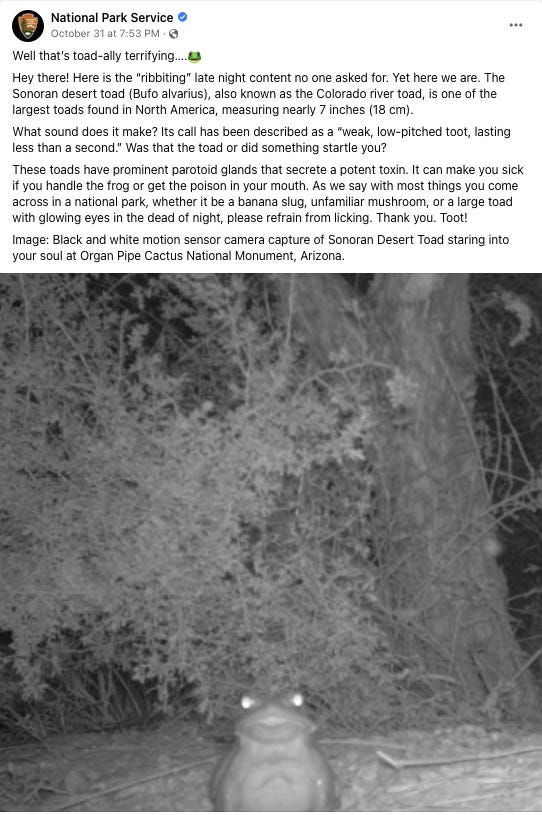Colorado and Oregon psychedelic ballot initiative updates, and don’t lick the toads
Plus: Ancient Peruvians used San Pedro and ayahuasca, and how veterans helped the psychedelic renaissance gain steam
Happy Veterans’ Day, and welcome back to The Microdose.
Colorado results
On Tuesday, Coloradoans voted by a small margin to approve Proposition 122, a ballot initiative to establish psilocybin services in the state and allows the state to explore providing other services using other naturally occurring psychedelics in the future.
On Wednesday evening, Natural Medicine Colorado, the group behind the initiative, declared victory with more than 80% of the vote counted. The Denver Post confirmed that Protect Colorado’s Kids, a group created to oppose the initiative, had conceded.
As of Friday morning, 92% of votes had been counted. Of the counted votes, 52.3 percent were in favor and 47.7 percent against.
The Latest in Oregon: The opt-out vote
Voters in 27 Oregon counties and dozens of cities weighed in on allowing psilocybin services in their municipalities, with most of them voting to prohibit them. In August and September, a rash of municipalities moved to add ballot measures to opt out of the state’s Measure 109, which goes into effect next year.
The wording of municipalities’ ballot measures varied; some specified a temporary ban of two years while other bans were permanent, and some banned manufacturing psilocybin or psilocybin services while others placed a blanket ban on all psilocybin-related businesses. Of the municipalities that introduced such ballot measures, the majority of voters in those areas approved bans. In some municipalities, like the city of Jordan Valley in Malheur County, support was as high as 87%. Voters opposed bans in just four counties — Deschutes, Douglas, Jackson, and Josephine. That means that some form of psilocybin-related business will be banned across the majority of Oregon counties, which seems certain to complicate the rollout of Measure 109.
Don’t lick the toads
On Halloween, the National Parks Service posted about the Sonoran desert toads on Facebook. “These toads have prominent parotoid glands that secrete a potent toxin. It can make you sick if you handle the frog or get the poison in your mouth,” the agency wrote. “As we say with most things you come across in a national park, whether it be a banana slug, unfamiliar mushroom, or a large toad with glowing eyes in the dead of night, please refrain from licking.”
Parkgoers might be curious about these toads because their secretions also contain 5-MeO-DMT, a potent psychedelic that’s being tested for use in treatment of depression, PTSD, and addiction. However, doses of 5-MeO-DMT require toad secretions to be dried and crystallized so that it might be smoked; directly licking a toad means ingesting other toxins, too. For years, conservationists and scientists have been concerned about declining Sonoran desert toad populations and worry that poachers harvesting toads for 5-MeO-DMT might further reduce the toad’s numbers.
Ancient Peruvians used San Pedro and ayahuasca
Ancient peoples on the southern Peruvian coast likely used psychedelics, three scholars report in a new paper published in the Journal of Archaeological Science. The trio studied hair samples from 22 mummified bodies of people who were victims of ritualized sacrifice. The people likely lived around 2000 years ago, between 400 BCE and 400 CE.
Researchers tested hair samples from each head for organic compounds to understand what ancient medicines those peoples may have used. Samples tested positive for harmine and harmaline, two alkaloids that are found in Banisteriopsis caapi, a vine which is used to make ayahuasca; and San Pedro, a cactus that contains mescaline. Because Banisteriopsis caapi is native to the Amazon rainforest, which is hundreds of miles from the Peruvian coast, the researchers’ findings suggest that ancient people must have engaged in long-distance trade for these substances.
There has never been a more exciting – or bewildering – time in the world of psychedelics. Don’t miss a beat.
A free newsletter from the U.C. Berkeley Center for the Science of Psychedelics
How veterans jump started the psychedelic renaissance
In the first piece for an investigative series on psychedelics research and commercialization for Truthdig, journalist Russell Hausfeld dives into the history of psychedelic prohibition, and how mental health treatments for veterans came to be a major focus of psychedelic research and funding initiatives. Hausfeld details Rick Doblin and MAPS’ role in launching psychedelic studies with veteran participants as part of a larger strategy to draw conservative support, and the controversy that led to within the psychedelics community:
“Successfully treating anyone’s PTSD is a laudable goal,” [psychedelic cultural commentator Erik] Davis wrote in Erowid Extracts in 2013. “But the sentimentality and heroic triumphalism that MAPS taps in order to publicize this research (funded by 25 years of contributions from psychedelic culture freaks) glosses over the disturbing possibility that MDMA therapy could one day be used with active-duty soldiers, a deployment that turns the compound into affective grease for the military machine.”
The piece also notes which conservative funders have supported MAPS’ work with veterans including the Mercers, who are “known for their involvement in funding anti-abortion efforts and climate change denial” as well as funding the Trump campaign and key players behind the January 6 insurrection as well as the conservative social media platform Parler. Now that it’s clear that focusing on veterans can bring in bi-partisan support and funding, the strategy MAPS pioneered is being emulated by psychedelic startups, “many of which have followed MAPS’ lead and incorporated treatment of military service members into pilot projects, outreach efforts and advertising,” Hausfeld writes.
In Slate, CEO of the Oregon Hospice and Palliative Care Association Barbara Hansen and Shoshanna Ungerleider, founder of the non-profit End Well, write about why psychedelics could change end-of-life care.
Should climbers try incorporating psychedelics into their pre-climb routine? Former pro climber Delaney Miller explains the history of psychedelics in the sport, and interviews climbers about their experiences for a piece in Climbing. She even tries a microdose herself. (Fun fact for climbers: The beta for Yosemite classic Midnight Lightning was apparently uncovered thanks to an acid trip.)
For fans of funny, deep and irreverent TV: in the second season of the critically-acclaimed show Reservation Dogs (available to stream on Hulu), the eighth episode, called “This is Where the Plot Thickens,” follows two characters on a psychedelic trip. The episode showcases the all-Native writers’ room at their best: the episode turns common Indigenous tropes on their heads, and deftly maneuvers between the poignant and the absurd. It’s one of the most interesting depictions of a psychedelic experience we’ve ever seen on screen.
Scientists in the UK say restrictive licensing rules are hampering psychedelic research, according to a new piece in The Guardian.
You’re all caught up! Have a great weekend. We’ll be back in your inbox on Monday with a new issue of 5 Questions.
If you know anyone who might like the latest on psychedelics in their inbox, feel free to forward this to them, or click below.
Got tips? Email us at themicrodose@berkeley.edu.










Love these excellent dispatches! Thank you : ) Heads up: Josephine County in Oregon opted out by about 75%. So many locals feel burned by cannabis farmers who have grown the plant outside the government licensing scheme, in a way that has exploited people and the environment, that they are erroneously applying their ire to Measure 109 / psilocybin, even though it's entirely different.
The move was such a nice one